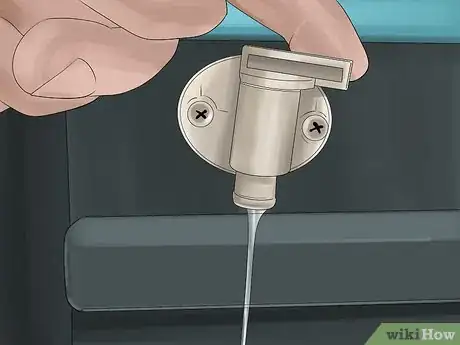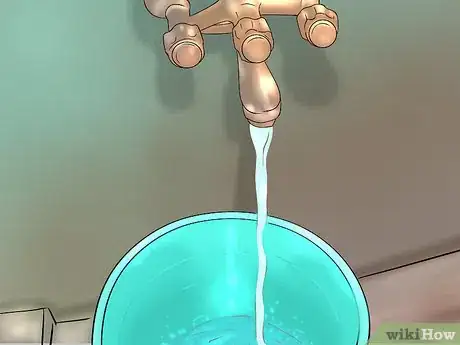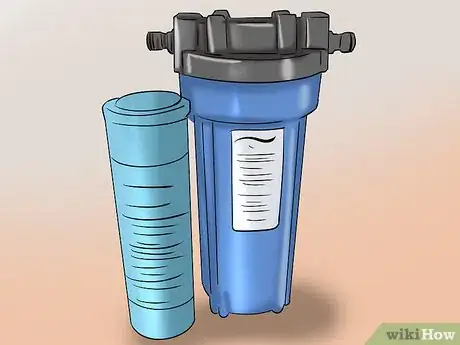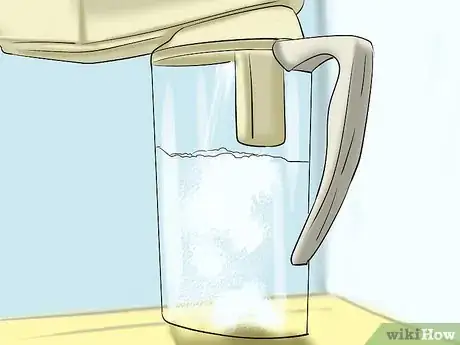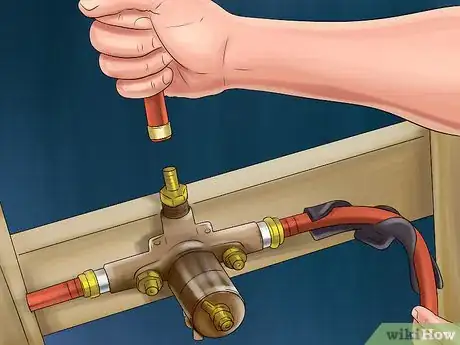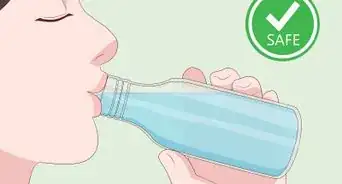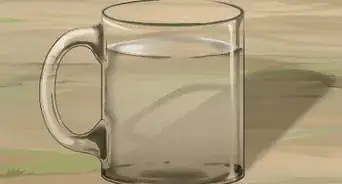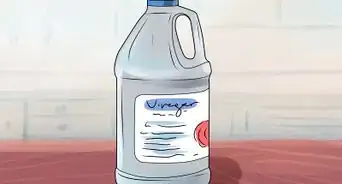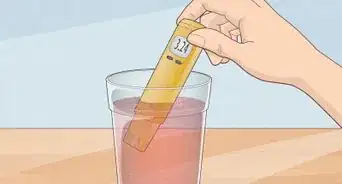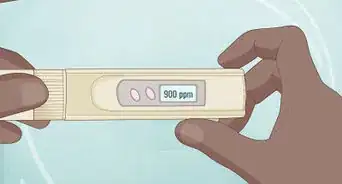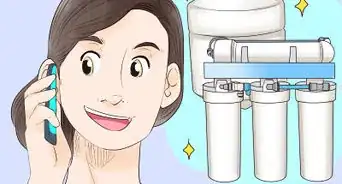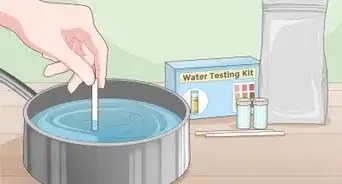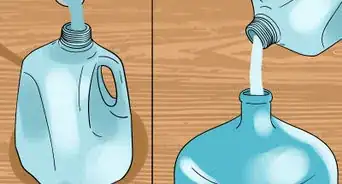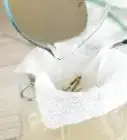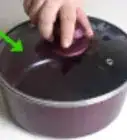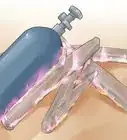This article was co-authored by wikiHow Staff. Our trained team of editors and researchers validate articles for accuracy and comprehensiveness. wikiHow's Content Management Team carefully monitors the work from our editorial staff to ensure that each article is backed by trusted research and meets our high quality standards.
This article has been viewed 46,649 times.
Learn more...
It is very dangerous to drink lead, especially for young children who are still developing. If you find out that your drinking water has lead in it, you will need to take action. By determining how much lead you have in your water, and then flushing your system, using a filter, or replacing your pipes, you can keep your water supply safe and drink it without worrying.
Steps
Finding out How Much Lead Is in Your Water
-
1Find an accredited water testing lab near you. To be absolutely certain how much lead you have in your water, you will need to get it tested. Contact your state or local government to find out which labs have been accredited for testing water. Your state’s branch of the Environmental Protection Agency should have this information.[1]
-
2Collect 2 samples of your water. First, you need to collect a first-draw sample, which is water that has been sitting in your pipes overnight. Fill a bottle with this sample first thing in the morning before you’ve run any water. Next, you’ll need a sample of running water, which is water that hasn’t sat in your pipes. Run your cold water tap for 2 minutes and then fill a water bottle.[2]Advertisement
-
3Take your water samples to the lab for testing and review results. By studying these 2 samples, the lab will be able to tell you how much lead you have in your water. This will help you determine what action you need to take.[3]
Flushing Your Pipes
-
1Turn on your cold water. If your water collects only trace amounts of lead (under 15 µg/L) from sitting in your pipes, you can remove it by flushing your pipes before using your water. When flushing your pipes, make sure you use only the cold water tap and never use the hot water tap.[4]
- Hot water melts lead and then mixes with it, so you should never use your hot water tap if you have lead in your water.[5]
-
2Let the water run for 2 minutes. After running your cold water for two minutes, all the water that has collected lead should be flushed out of the system.[6]
-
3Repeat this process for each faucet you want to use. When you run water, you are flushing only the pipes that lead to that specific faucet. You cannot expect your other faucets to have safe water.[7]
- You will also need to repeat the process every time you want water. If you need a more permanent solution, you should try a different method.
-
4Store water for future use. Clean out old water, soda, or milk bottles with soap, and then fill them with cold water from your flushed pipes. Leave them in the refrigerator or a cool, dark place. This way you will not have to flush your pipes every time you need to use water.[8]
- Discard stored tap water if you haven’t used it within 6 months.[9]
-
5Heat cold water if you need hot water. Again, you should never draw hot water if you have lead. If you need to cook, for instance, boil cold water that you’ve drawn from your flushed pipes.[10]
Using Water Treatments
-
1Use a reverse osmosis device for best results. If your running water has a lead concentration of more than 15 µg/L, you may want to get a point-of-use treatment solution. There are many different options, but a reverse osmosis device is usually the most effective point-of-use treatment solution. However, it is also relatively expensive to purchase and operate.[11]
- Reverse osmosis devices are usually installed under the sink and use tiny membranes to screen out harmful materials like lead.
- They also tend to waste water while treating it, which raises their operating cost.
- If you have well above 15 µg/L of lead in your water, you will definitely want to consider a reverse osmosis device despite its cost.
- The Water Quality Association is a reliable resource for finding effective treatment products.[12]
-
2Use a distiller or filter for a more cost effective solution. There are several different kinds of these products if you don’t need or can’t afford a reverse osmosis device. There are filters that fit right over your faucet for extremely convenient use. There are distillers that separate lead from your water over time and collect the clean water in a jug. And there are under-the-sink filters.[13]
- Before purchasing a distiller, make sure it is one that is approved by the Water Quality Association to remove lead from water. A regular Brita filter may not be enough to remove lead.
- If you want the convenience of filtering your water as soon as it comes out of the faucet, purchase a faucet filter.
- If you don’t want to take up space in your sink with a filter, purchase a distiller. Conveniently, many distillers also act as water dispensers.
-
3Follow the device’s instructions when setting it up and using it. This will ensure that you are using your device properly and removing as much lead from your water as possible. Be sure to follow maintenance recommendations as well.
- For instance, the filters in reverse osmosis devices must be replaced periodically. Your instruction manual should tell you how often your model’s filter needs to be changed.
- For filters that fit over your faucet, you will usually have to run cold water through the filter for 5 minutes the first time you use it.[14]
Replacing Lead Parts in Your Plumbing System
-
1Identify the source of lead in your well or home. Sometimes wells or homes have old lead parts that affect the water. Hire a professional who knows how to look for sources of lead to be sure you’re finding them properly. Contact your state or local government’s environmental or water agencies for recommendations.[15]
- If you have a well, you will want to speak with a licensed well water contractor.[16]
- If you do not have a well, you will want to consult a water treatment technician.
-
2Remove all copper pipes and lead solder. This is the most expensive option for getting lead out of your water, but it is also the most effective. To ensure that all the lead contaminants are removed properly, you will probably want to hire a plumber. This is a large and serious job that needs to be done with precision.[17]
- The cost of this process varies based on your region and the size of your home. But it can often cost between $4,000 and $10,000 to replace all the pipes in single-family home.[18]
-
3Replace old parts with PVC or PEX pipes. These newer materials will not contaminate your water. Once they are installed, your water should be totally lead-free. To be absolutely sure you no longer have lead in your water, have your water tested at a lab again.[19]
Warnings
- You cannot taste, smell, or see lead in your water. Testing your water in a lab is the only way to know for sure if you have lead in your water and how much you have.⧼thumbs_response⧽
- If your home was built before the 1980s, the pipes could be joined with lead solder even if they are made from a different material.⧼thumbs_response⧽
References
- ↑ https://extension.psu.edu/lead-in-drinking-water
- ↑ https://extension.psu.edu/lead-in-drinking-water
- ↑ https://extension.psu.edu/lead-in-drinking-water
- ↑ https://www.cdc.gov/healthywater/drinking/private/wells/disease/lead.html
- ↑ https://www.cdc.gov/healthywater/drinking/private/wells/disease/lead.html
- ↑ https://www.cdc.gov/healthywater/drinking/private/wells/disease/lead.html
- ↑ https://www.cdc.gov/healthywater/drinking/private/wells/disease/lead.html
- ↑ https://extension.psu.edu/lead-in-drinking-water
- ↑ https://extension.psu.edu/how-to-store-water-for-drinking-or-cooking
- ↑ https://www.cdc.gov/healthywater/drinking/private/wells/disease/lead.html
- ↑ http://www.health.state.mn.us/divs/eh/water/factsheet/com/poulead.html
- ↑ http://www.health.state.mn.us/divs/eh/water/factsheet/com/poulead.html
- ↑ http://www.health.state.mn.us/divs/eh/water/factsheet/com/poulead.html
- ↑ http://www.michigan.gov/documents/flintwater/BRITA_Filter_Fact_Sheet_FINAL_2516_514031_7.pdf
- ↑ https://www.cdc.gov/healthywater/drinking/private/wells/disease/lead.html
- ↑ https://www.cdc.gov/healthywater/drinking/private/wells/disease/lead.html
- ↑ https://extension.psu.edu/lead-in-drinking-water
- ↑ https://www.houselogic.com/organize-maintain/home-maintenance-tips/do-you-need-replace-your-plumbing/
- ↑ https://extension.psu.edu/lead-in-drinking-water

